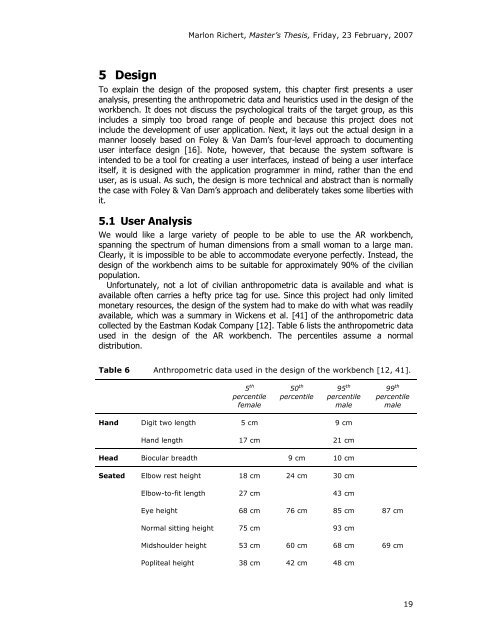The AR Workbench: A Complete Co-located Reach-in Mirror-Based ...
The AR Workbench: A Complete Co-located Reach-in Mirror-Based ...
The AR Workbench: A Complete Co-located Reach-in Mirror-Based ...
You also want an ePaper? Increase the reach of your titles
YUMPU automatically turns print PDFs into web optimized ePapers that Google loves.
5 Design<br />
Marlon Richert, Master’s <strong>The</strong>sis, Friday, 23 February, 2007<br />
To expla<strong>in</strong> the design of the proposed system, this chapter first presents a user<br />
analysis, present<strong>in</strong>g the anthropometric data and heuristics used <strong>in</strong> the design of the<br />
workbench. It does not discuss the psychological traits of the target group, as this<br />
<strong>in</strong>cludes a simply too broad range of people and because this project does not<br />
<strong>in</strong>clude the development of user application. Next, it lays out the actual design <strong>in</strong> a<br />
manner loosely based on Foley & Van Dam’s four-level approach to document<strong>in</strong>g<br />
user <strong>in</strong>terface design [16]. Note, however, that because the system software is<br />
<strong>in</strong>tended to be a tool for creat<strong>in</strong>g a user <strong>in</strong>terfaces, <strong>in</strong>stead of be<strong>in</strong>g a user <strong>in</strong>terface<br />
itself, it is designed with the application programmer <strong>in</strong> m<strong>in</strong>d, rather than the end<br />
user, as is usual. As such, the design is more technical and abstract than is normally<br />
the case with Foley & Van Dam’s approach and deliberately takes some liberties with<br />
it.<br />
5.1 User Analysis<br />
We would like a large variety of people to be able to use the <strong>AR</strong> workbench,<br />
spann<strong>in</strong>g the spectrum of human dimensions from a small woman to a large man.<br />
Clearly, it is impossible to be able to accommodate everyone perfectly. Instead, the<br />
design of the workbench aims to be suitable for approximately 90% of the civilian<br />
population.<br />
Unfortunately, not a lot of civilian anthropometric data is available and what is<br />
available often carries a hefty price tag for use. S<strong>in</strong>ce this project had only limited<br />
monetary resources, the design of the system had to make do with what was readily<br />
available, which was a summary <strong>in</strong> Wickens et al. [41] of the anthropometric data<br />
collected by the Eastman Kodak <strong>Co</strong>mpany [12]. Table 6 lists the anthropometric data<br />
used <strong>in</strong> the design of the <strong>AR</strong> workbench. <strong>The</strong> percentiles assume a normal<br />
distribution.<br />
Table 6 Anthropometric data used <strong>in</strong> the design of the workbench [12, 41].<br />
5 th<br />
percentile<br />
female<br />
50 th<br />
percentile<br />
95 th<br />
percentile<br />
male<br />
Hand Digit two length 5 cm 9 cm<br />
Hand length 17 cm 21 cm<br />
Head Biocular breadth 9 cm 10 cm<br />
Seated Elbow rest height 18 cm 24 cm 30 cm<br />
Elbow-to-fit length 27 cm 43 cm<br />
99 th<br />
percentile<br />
male<br />
Eye height 68 cm 76 cm 85 cm 87 cm<br />
Normal sitt<strong>in</strong>g height 75 cm 93 cm<br />
Midshoulder height 53 cm 60 cm 68 cm 69 cm<br />
Popliteal height 38 cm 42 cm 48 cm<br />
19
















